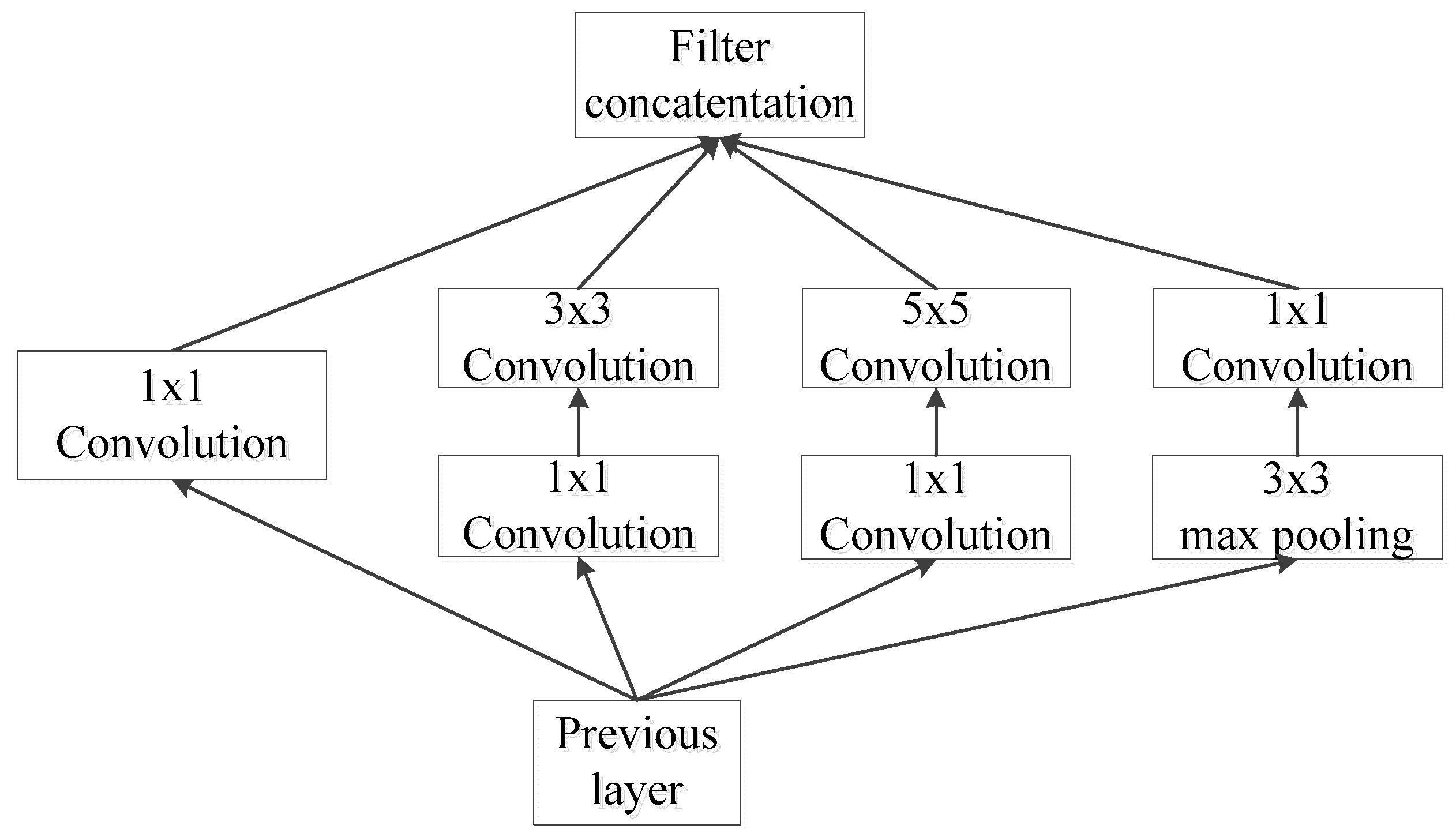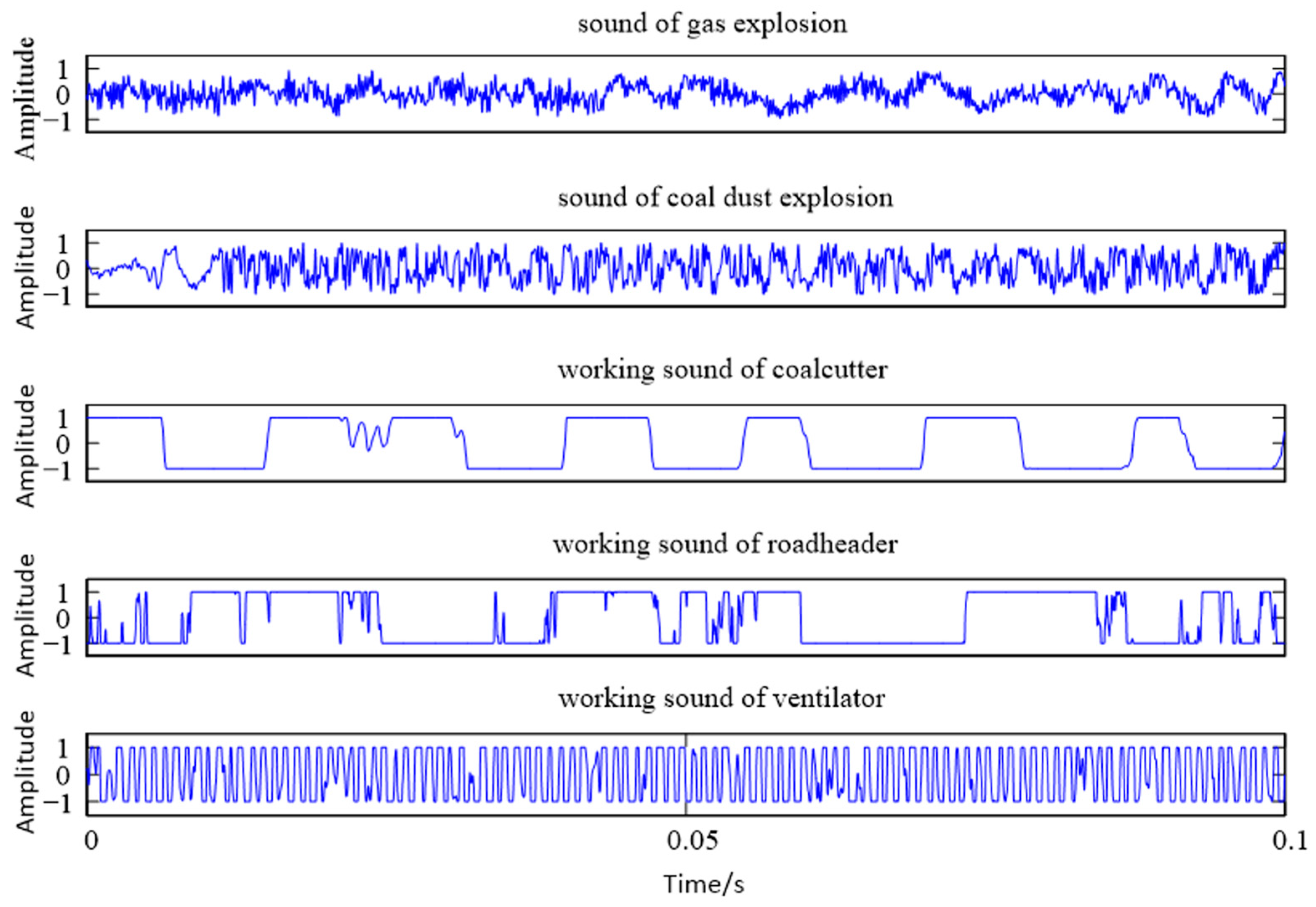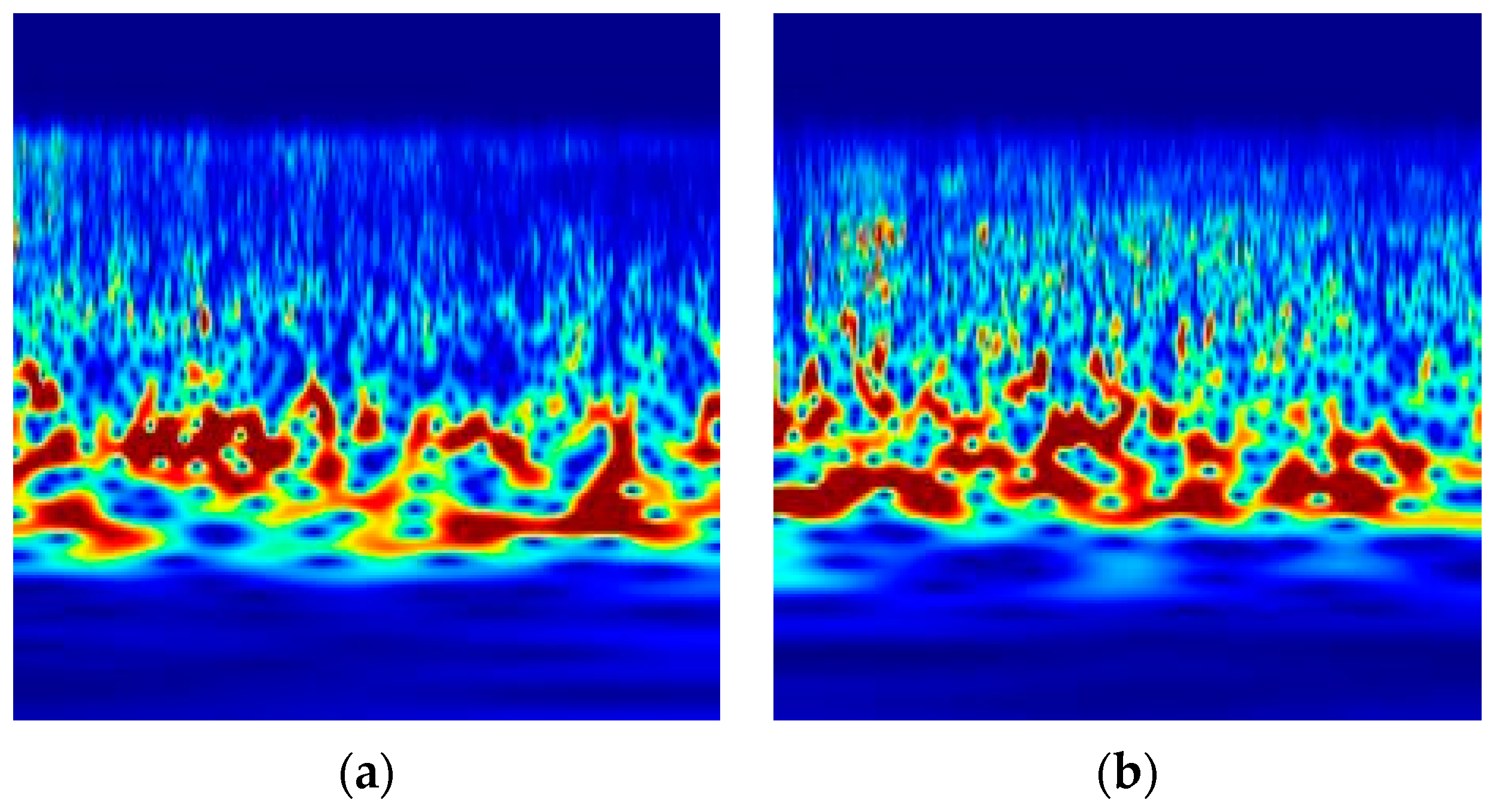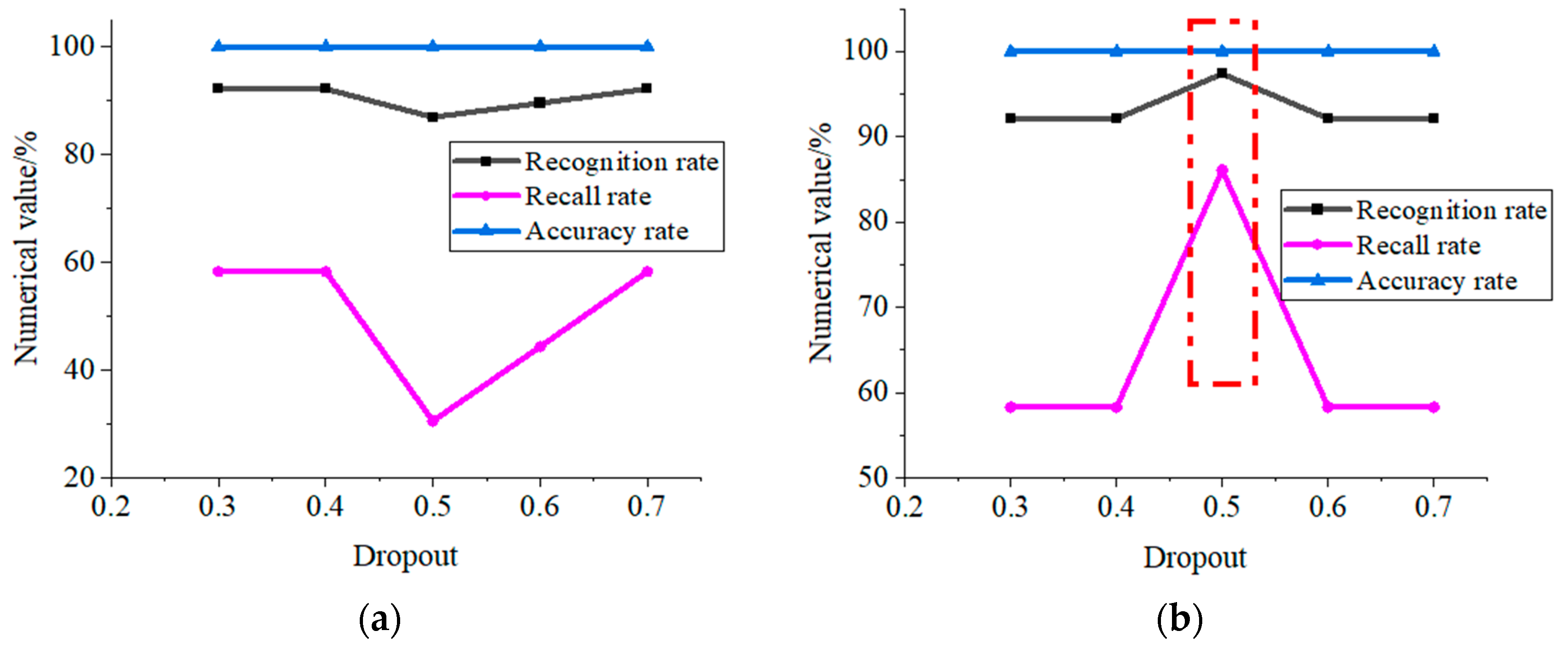Sound Recognition Method of Coal Mine Gas and Coal Dust Explosion Based on GoogLeNet
Abstract
1. Introduction
2. Preprocessing
2.1. Normalization
2.2. Framing
2.3. Category Labels
3. Continuous Wavelet Transform
4. GoogLeNet
5. Experimental Results and Analysis
5.1. Experimental Material
5.2. Wavelet Coefficient Map Extraction
5.3. Parameter Experiments
6. Experimental Results and Analysis
6.1. Experimental Results
6.2. Experimental Analysis
7. Conclusions
Author Contributions
Funding
Data Availability Statement
Conflicts of Interest
References
- Li, Y.Z.; Su, H.T.; Ji, H.J.; Cheng, W.Y. Numerical simulation to determine the gas explosion risk in longwall goaf areas: A case study of Xutuan Colliery. Int. J. Min. Sci. Technol. 2020, 30, 875–882. [Google Scholar] [CrossRef]
- Lin, B.Q.; Hong, Y.D.; Zhu, C.J.; Youjiang, B.; Liu, Q.; Sun, Y.M. Quantitative relationship between flow speed and overpressure of gas explosion in the open-end square tube. Explos. Shock Waves 2015, 35, 108–115. [Google Scholar]
- Si, R.J.; Li, R.Z.; Su, D.F. Investigation of the influence of the coal dust cloud on the gas explosion pressure. J. Saf. Environ. 2018, 18, 1796–1798. [Google Scholar] [CrossRef]
- Yu, M.G.; Yang, X.F.; Zheng, K.; Luan, P.P. Progress and development of coal mine gas explosion suppression and disaster reduction technology in China. J. China Coal Soc. 2020, 45, 168–188. [Google Scholar] [CrossRef]
- Cheng, F.M.; Nan, F.; Luo, Z.M.; Kang, X.F. Research progress and development trend of gas explosion suppression materials and mechanism. Coal Sci. Technol. 2021, 49, 114–124. [Google Scholar] [CrossRef]
- Yin, W.T.; Fu, G.; Zhu, K.; Yang, C. Reason Analysis of Gob Gas Explosion Based on Behavioral Safety. Saf. Coal Mines 2015, 46, 239–241. [Google Scholar] [CrossRef]
- Sun, J.P. Research on method of coal mine gas and coal dust explosion perception alarm and explosion source judgment. Ind. Mine Autom. 2020, 46, 1–5. [Google Scholar] [CrossRef]
- Sun, J.P.; Yu, X.C. Research on alarm method of coal mine extraordinary accidents based on sound recognition. Ind. Mine Autom. 2021, 47, 1–5. [Google Scholar] [CrossRef]
- Sun, J.P.; Yu, X.C. Recognition method of coal mine gas and coal dust explosion based on sound characteristics. J. China Univ. Min. Technol. 2022, 51, 1096–1105. [Google Scholar] [CrossRef]
- Sun, J.P.; Yu, X.C. Sound recognition method of coal mine gas and coal dust explosion based on CEEMD component sample entropy and SVM classification. J. Min. Saf. Eng. 2022, 39, 1061–1070. [Google Scholar] [CrossRef]
- Zhang, K.X.; Long, Z.; Wang, X.F.; Zhao, F. Detection of Wheeze Based on Hough Transform of Spectrogram. J. Northeast. Univ. Nat. Sci. 2017, 38, 1534–1537. [Google Scholar]
- Li, J.R.; Hong, Y. Wheeze detection method based on spectrogram entropy analysis. Acta Acust. 2020, 45, 131–136. [Google Scholar] [CrossRef]
- Zeng, J.F.; Huang, F.Z.; Bai, B.; Xu, L.T. Sound event recognition based on texture features of cochleagram. Tech. Acoust. 2020, 39, 69–75. [Google Scholar] [CrossRef]
- Wei, J.; Ding, Z.K.; Ning, F.L. Spectrogram extraction method for acoustic scene data based on neural network. Syst. Eng. Electron. 2021, 43, 3462–3469. [Google Scholar]
- Yang, S.Y.; Gui, B.B.; Yongchen, S. Arrhythmia Detection Based on Wavelet Decomposition and 1D-GoogLeNet. J. Electron. Inf. Technol. 2021, 43, 3018–3027. [Google Scholar]
- Wang, C.; Zhu, H.P. Structural time-varying frequency identification under moving load based on generalized Morse wavelet and EWT. J. Vib. Shock 2020, 39, 24–28. [Google Scholar] [CrossRef]
- Feng, X.J.; Li, S.; Huan, X.X. Civil aviation QAR data reduction and it’s performance analysis based on wavelet scaling coefficients. Comput. Eng. Des. 2009, 30, 1255–1258. [Google Scholar] [CrossRef]
- Lilly, J.M.; Olhede, S.C. Generalized Morse Wavelets as a Superfamily of Analytic Wavelets. IEEE Trans. Signal Process. 2012, 60, 6036–6041. [Google Scholar] [CrossRef]
- Whitney, R. Quantifying near fault pulses using generalized Morse wavelets. J. Seismol. 2019, 23, 1115–1140. [Google Scholar] [CrossRef]
- Szegedy, C.; Liu, W.; Jia, Y.Q.; Sermanet, P.; Reed, S.; Anguelov, D.; Erhan, D.; Vanhoucke, V.; Rabinovich, A. Going deeper with convolutions. In Proceedings of the IEEE Conference on Computer Vision and Pattern Recognition, Boston, MA, USA, 7–12 June 2015; pp. 1–9. [Google Scholar]
- Zhu, W.; Ma, L.X.; Zhang, P.; Liu, D.Y. Morphological recognition of rice seedlings based on GoogLeNet and UAV image. J. South China Agric. Univ. 2022, 43, 99–106. [Google Scholar]








| Sound Type | Total Duration/s | Number of Sound Clips | Data Volume/MB |
|---|---|---|---|
| Gas explosion sound | 10 | 5 | 3 |
| Coal dust explosion sound | 10 | 5 | 3 |
| Coal mine underground Non-explosion sound | 8000 | 800 | 734 |
| Evaluation Indicators | Gas Explosion | Coal Dust Explosion | Coal Mining Machine | Roadheader | Ventilator |
|---|---|---|---|---|---|
| Mean | 93.4 | 96.0 | 82.9 | 105.2 | 87.1 |
| Entropy | 6.2 | 6.2 | 5.7 | 7.1 | 6.2 |
| Standard deviation | 95.9 | 93.9 | 94.8 | 88.3 | 91.0 |
| Mean gradient | 11.4 | 13.8 | 6.2 | 21.3 | 10.7 |
| Percentage of Training | Model | Recognition Rate/% | Recall Rate/% | Accuracy Rate/% | Training Time/s |
|---|---|---|---|---|---|
| 10% | GoogLeNet | 97.38 | 86.1 | 100 | 124 |
| VGG | 81.15 | 0 | 0 | 193 | |
| Alexnet | 89.53 | 44.4 | 100 | 25 | |
| 20% | GoogLeNet | 100 | 100 | 100 | 238 |
| VGG | 85.88 | 25 | 100 | 385 | |
| Alexnet | 92.35 | 59.35 | 100 | 45 |
Disclaimer/Publisher’s Note: The statements, opinions and data contained in all publications are solely those of the individual author(s) and contributor(s) and not of MDPI and/or the editor(s). MDPI and/or the editor(s) disclaim responsibility for any injury to people or property resulting from any ideas, methods, instructions or products referred to in the content. |
© 2023 by the authors. Licensee MDPI, Basel, Switzerland. This article is an open access article distributed under the terms and conditions of the Creative Commons Attribution (CC BY) license (https://creativecommons.org/licenses/by/4.0/).
Share and Cite
Yu, X.; Li, X. Sound Recognition Method of Coal Mine Gas and Coal Dust Explosion Based on GoogLeNet. Entropy 2023, 25, 412. https://doi.org/10.3390/e25030412
Yu X, Li X. Sound Recognition Method of Coal Mine Gas and Coal Dust Explosion Based on GoogLeNet. Entropy. 2023; 25(3):412. https://doi.org/10.3390/e25030412
Chicago/Turabian StyleYu, Xingchen, and Xiaowei Li. 2023. "Sound Recognition Method of Coal Mine Gas and Coal Dust Explosion Based on GoogLeNet" Entropy 25, no. 3: 412. https://doi.org/10.3390/e25030412
APA StyleYu, X., & Li, X. (2023). Sound Recognition Method of Coal Mine Gas and Coal Dust Explosion Based on GoogLeNet. Entropy, 25(3), 412. https://doi.org/10.3390/e25030412






